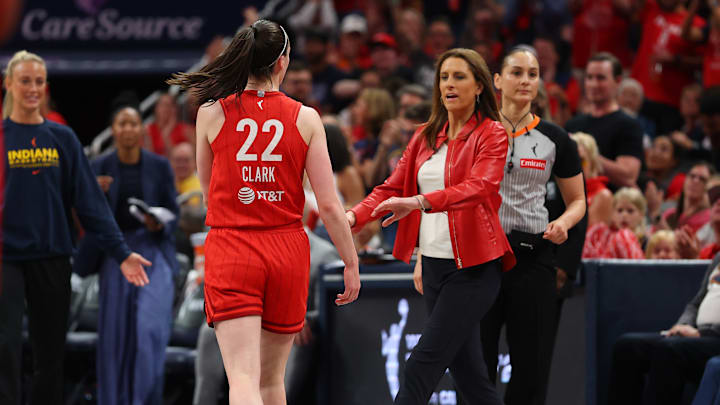The sellout crowds, the deafening cheers, the endless sea of #22 jerseys—for months, this has been the reality of the Indiana Fever. The franchise, and to a large extent the entire WNBA, has been riding the whirlwind known as the Caitlin Clark effect.
Her presence alone guaranteed national attention, commercial success, and a baseline level of on-court excitement. But what happens when the whirlwind suddenly dissipates? For one night, the basketball world found out.
With Clark sidelined, the curtain was pulled back on the Fever, and what was revealed was not a well-oiled machine momentarily missing its main gear, but a collection of parts that seemed to have forgotten how to function.

The ensuing performance didn’t just lead to a loss; it ignited a firestorm of fan criticism aimed squarely at the team’s architect, Head Coach Stephanie White.
The game itself was a difficult watch for anyone wearing Indiana colors. The vibrant, if sometimes chaotic, energy that Clark brings was replaced by a stark and painful silence in the offense.
Possessions that usually culminated in a deep three-point attempt or a dazzling assist now ended in hesitant passes, stagnant dribbling, and forced, low-percentage shots.
The team looked utterly rudderless, a ship without a captain, navigator, or even a clear destination. Players who were supposed to be complementary pieces suddenly looked lost without their centerpiece.
The offensive flow evaporated, replaced by a disjointed and predictable attack that the opposing defense dismantled with ease. It was a stark reminder that while one player can elevate a team, the system itself must be strong enough to stand on its own.
The immediate aftermath was brutal and played out in the unforgiving court of public opinion: social media. The digital pitchforks came out for Coach White. Fans, who had joyfully ridden the Clark wave, now unleashed a torrent of criticism and frustration.
The questions were pointed and relentless. “What is the offensive system beyond ‘let Caitlin cook’?” one fan lamented. “Where was the plan B? Or was there never a plan A to begin with?” another posted.
The sentiment was clear and overwhelming. The absence of one rookie, no matter how talented, should not cause a professional basketball team to completely collapse.
The blame, in the eyes of the fanbase, fell on the coach for fostering an environment of such extreme over-reliance and for failing to develop a cohesive team identity that could survive the absence of its star.
This wasn’t just blind fan anger; it exposed a legitimate and growing concern about the Fever’s long-term health. The game without Clark served as a harsh diagnostic test, and the results were alarming.
The primary flaw it revealed was a seeming lack of a structured, adaptable offensive philosophy. A sound coaching system should have principles and actions that generate good looks regardless of who is on the floor.
While the quality of those looks would naturally decline without a player of Clark’s caliber, the fundamental process should remain. Instead, the Fever’s offense appeared to be built entirely on the foundation of Clark’s individual brilliance.
When that foundation was removed, the entire structure crumbled. This raised uncomfortable questions about whether the coaching staff had prepared the team for any sort of adversity.
The flaws exposed ran deeper than just in-game strategy; they touched upon roster construction and player development. With Clark out, the need for a reliable secondary playmaker and shot creator became painfully obvious.
The Fever roster, as it is currently assembled, appears to lack that crucial element. There was no one who could consistently break down the defense, command a double team, and create for others in Clark’s stead.
This is a critique that extends beyond a single game and falls at the feet of the coaching staff and front office. Building a team around a generational talent is one thing; building a team that is wholly dependent on them is a dangerous gamble, and for one night, that gamble failed spectacularly.
Of course, a defense of Stephanie White is not without merit. She is navigating one of the most difficult and high-pressure coaching situations in all of sports. She was handed a transcendent talent and, with her, the impossible expectations of instant success for a team that won only 13 games last season.
Integrating a player as ball-dominant and unique as Clark is not a simple, plug-and-play operation. It takes time to build chemistry, define roles, and develop a system that maximizes the star while also empowering the supporting cast.
The entire league is adjusting to Clark, and it is only logical that her own team is still in the early, often messy, stages of that same process. The intense spotlight leaves no room for growing pains, and every stumble is magnified a thousand times over.
Perhaps the most troubling aspect of the performance was its impact on Aliyah Boston. The reigning Rookie of the Year and former No. 1 overall pick was expected to thrive as the undisputed first option. This was her chance to remind the world of the dominant force she was and can be. Instead, she too seemed caught in the team’s overall malaise.
The offense wasn’t consistently run through her in the post, and she struggled to establish the commanding presence that defined her rookie campaign. This failure to elevate Boston in Clark’s absence added another layer to the critique of White.
A key responsibility of a coach is to put their best players in positions to succeed, and many fans felt that the game plan failed to accomplish this for Boston when she was needed most.
In a strange way, this humbling and public failure could be the best thing to happen to the Indiana Fever this season. It was a necessary, if painful, wake-up call. It stripped away the intoxicating buzz of the “Caitlin Clark Show” and forced the team and its coaches to confront the uncomfortable truth of their dependency.
This single game provided an undeniable data point, a full 48 minutes of film showcasing precisely where the system breaks down. It is a lesson that could not have been learned in a practice or a film session. It had to be experienced, in all its frustrating glory, on a professional court with the world watching.

The blistering fan reaction, while harsh, comes from a place of passion and newfound hope for a franchise long dormant. They have tasted what is possible, and they fear it being squandered.
The pressure is now immense and squarely on the shoulders of Stephanie White. Her task has been redefined. It is not simply to manage the career of Caitlin Clark, but to build a resilient, multi-faceted team.
She must cultivate an identity that runs deeper than one player’s stat line. The loss exposed the flaws in the Fever’s blueprint; now, it is up to the architect to prove she can reinforce the foundation and build something that is meant to last.


